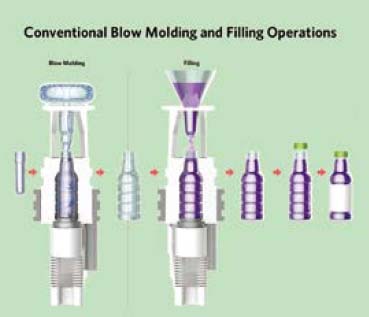The latest technology in blow moulding is geared towards cost and weight reduction, while bringing multiple benefits to manufacturers of bottled products. LiquiForm™ is a revolutionary blow moulding and filling manufacturing technology which uses consumable, pressurised liquid instead of compressed air to form plastic containers.
By combining the bottle forming and filling processes into one step, this game changing technology eliminates numerous manufacturing steps, significantly reducing cost and waste. As a result, the manufacturing process is more environmentally efficient compared to traditional blow moulding and filling operations, offering customers the most efficient method to manufacture their products.
The LiquiForm has been validated with a significant range of packaging substrates, products and conditions using the same LiquiForm machine for cold, ambient, and hot-fill PET containers. Counting on the benefits The LiquiForm process is considered the most advanced forming/filling system. The process will enable significant reduction in the energy required for bottling as it eliminates the need for compressed air. For standard blow moulding, the air compression cycle is only 35% to 40% efficient and consumes about 70% of the total amount of electricity used in the blow moulding process. LiquiForm uses much less electricity to hydraulically drive incompressible fluid into the container while it is forming at a much higher efficiency.
This will reduce environmental impacts through a reduction in the greenhouse gas emissions associated with the energy used to form the bottle. The one step LiquiForm process also represents a reduction in the waste, downtime and labour associated with operating and supporting two separate machines, particularly in reducing hangeover and maintenance waste.
Standard bottle making and filling operations are typically performed by two separate pieces of equipment. The LiquiFormproces requires a footprint which compares to a traditional blow moulder, dramatically reducing floor space requirements. Another important benefit lies in design. The LiquiForm process optimises PET bottle design both in terms of lightweighting and potentially sharper bottle definition because better pressure
control and material distribution is possible with liquid instead of air which allows for minimum wall thicknesses.


The lightweight bottles possible with LiquiForm means filled bottles weigh less, reducing the greenhouse gas emissions associated with transportation. For supply chains using converter suppliers, the transportation of unfilled containers between factories is also eliminated. This reduces the inherent risk of damage and the risk of contamination in moving and warehousing unfilled bottles across multiple manufacturing sites. A group of leading players in the blow moulding sector has initiated the development of the LiquiForm process. Amcor developed the LiquiForm concept in 2006, and subsequently set up a joint venture which owns the patented LiquiForm technology and related intellectual property. Amcor and Sidel, a global provider of PET solutions for liquid packaging, each owns a 50% interest in the joint venture. The joint venture will issue licences allowing machine manufacturers to produce and sell equipment using the LiquiForm technology.
Lightweighting calculation
Another initiative launched by Sidel points towards reducing the amount of PET used in beverage bottles worldwide, thereby helping producers to save money and improve their environmental footprint at the same time. To allow beverage producers and bottlers to calculate for themselves what savings could be achieved based on their own production parameters, Sidel has introduced an online PET savings calculator. In the past few months, Sidel has launched several bottle design innovations, including its RightWeight™ bottle concept, which can be applied across categories, and its range of SidelStarLite™ bottle bases for water and CSD. RightWeight is the proprietary bottle design process that Sidel uses to ensure a bottle is both light while also strong enough to survive global supply chains, look good at the point of sale and offer a great consumer experience.
Modern bottle designs can lead to substantial savings for beverage producers worldwide. To make it as easy as possible to see the actual savings that can be achieved, Sidel has now launched a PET savings calculator, available at www.sidel.com/PETsavings - calculator. This enables water and CSD producers to easily calculate how much they could save by utilising a SidelStarLite base and a shorter neck. The calculator allows producers to enter their current production conditions for water or CSD products, such as current bottle neck format, raw material costs, annual production hours and blower speed etc. for a range of bottle formats. It then immediately calculates how much money could be saved per line by simply adapting the bottle design to use the SidelStarLite base and shorter neck.
According to Sidel data, the average line can save between $300,000 and $ 1 million, with faster lines or larger bottle formats capable of saving even more. This leads to an approximate average saving per bottle of up to 0.005 dollars per 0.5 litre bottle or 0.007 dollars per 2 litre bottle for still water, and 0.005 dollars per 0.5 litre bottle or 0.006 dollars per 2 litre bottle for CSD. Based onEuromonitor forecasts for 2014-2018, released in March 2014, 216 billion PET bottles for still water and 116 billion PET bottles for CSD will have been produced by the end of the year. Assuming a minimum saving of 0.005 dollars for all those bottles, the beverage industry as a
whole could save 1.08 billion dollars for water and 580 dollars for CSD.In total this equates to over $ 1.66 billion potential cost savings for the beverage industry from water and CSD alone. This does not include other categories such as juices, liquid dairy products and other products.














